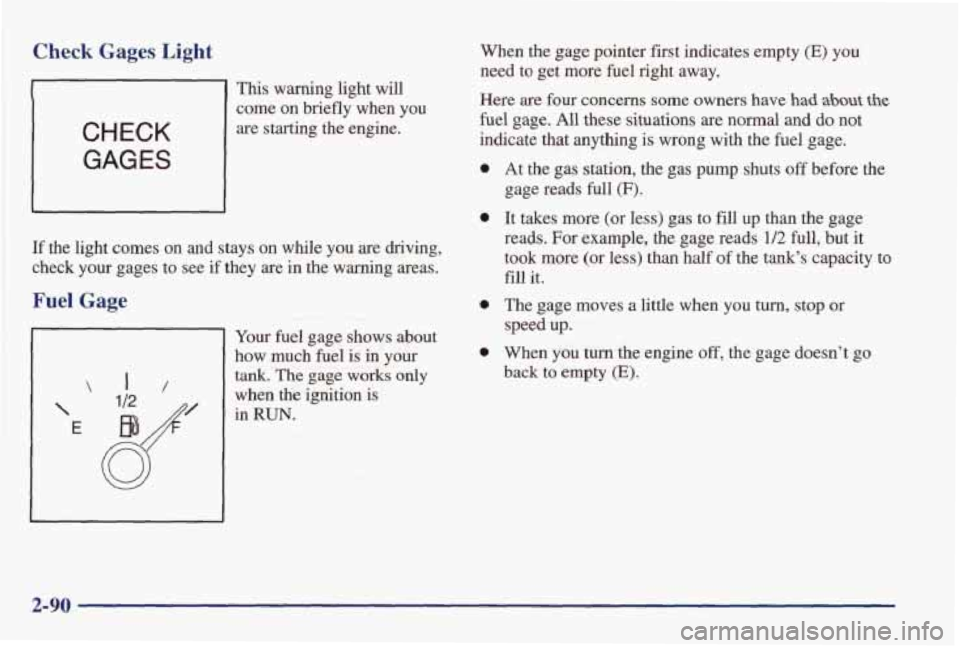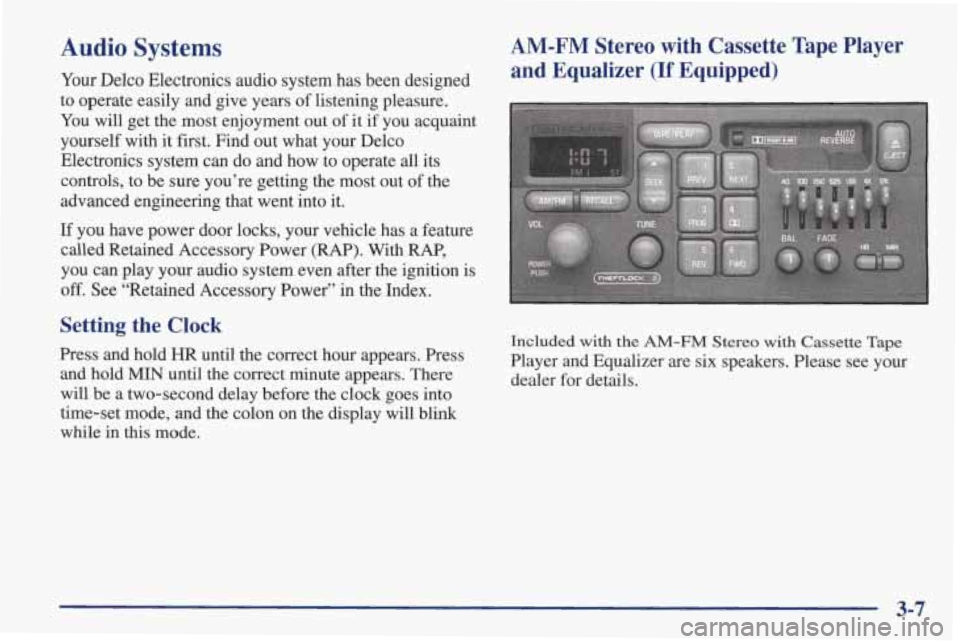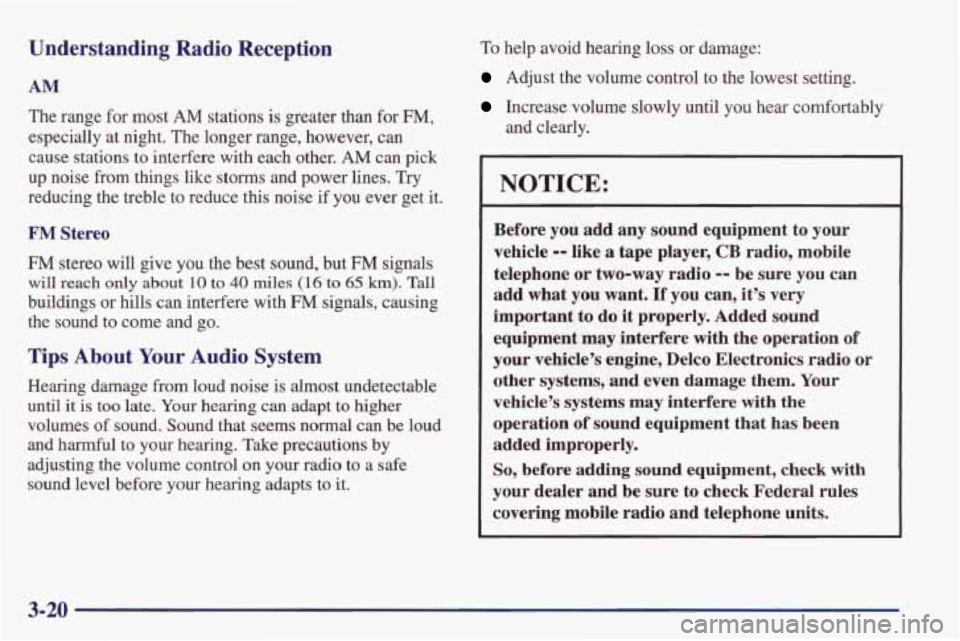engine PONTIAC FIREBIRD 1998 Owner's Guide
[x] Cancel search | Manufacturer: PONTIAC, Model Year: 1998, Model line: FIREBIRD, Model: PONTIAC FIREBIRD 1998Pages: 406, PDF Size: 18.23 MB
Page 140 of 406

Low Coolant Light (5.7L V8 Engine)
This warning light should
come on while you are
starting your engine.
If the
light doesn’t come on, have
it repaired.
~
Your vehicle is equipped with a low coolant indicator
which is designed to detect when the coolant level drops
below set limits.
If the low coolant level sensor (on the
radiator) drops while the engine is running, the low
coolant indicator will light and remain lit until the
ignition
is turned to OFF. Check coolant level and add
coolant as needed. The low coolant light might stay on
after filling the radiator. Turn the ignition to
OFF, then
restart
the engine to verify that the low coolant light
goes out. See “Engine Coolant” in the Index.
NOTICE:
Driving with the low coolant light on could cause
your vehicle to overheat. See “Engine Overheating”
in the Index. Your vehicle could be damaged and it
wouldn’t be covered by your warranty.
Malfunction Indicator Lamp
(Service Engine
Soon Light)
SERVICE
ENGINE
SOON
Your vehicle is equipped
with a computer which
monitors operation of the
fuel, ignition and emission
control systems.
2-85
Page 141 of 406

This system is called OBD I1 (On-Board
Diagnostics-Second Generation) and
is intended to
assure that emissions
are at acceptable levels for the life
of the vehicle, helping to produce a cleaner
environment. The
SERVICE ENGINE SOON light
comes on to indicate that there is a problem and service
is required. Malfunctions often will be indicated by the
system before any problem is apparent.
This may
prevent more serious damage to your vehicle.
This
system is also designed to assist your service technician
in correctly diagnosing any malfunction.
NOTICE:
If you keep driving your vehicle with this light
on, after a while,
your emission controls may not
work as well, your fuel economy
may not be as
good and your engine may not run as smoothly.
This could lead to costly repairs that may not be
covered by your warranty.
This light should come on, as a check to show you it is
working, when the ignition is on and the engine is not
running.
If the light doesn’t come on, have it repaired.
This light will also come on during a malfunction in one
of two ways:
0 Light Flashing -- A misfire condition has been
detected. A misfiie increases vehicle emissions and
may damage the emission control system on your
vehicle. Dealer or qualified service center diagnosis
and service may be required.
Light On Steady -- An emission control system
malfunction has been detected on your vehicle.
Dealer or qualified service center diagnosis and
service may be required.
2-86
Page 142 of 406

If the Light Is Flashing If the Light Is On Steady
The following may prevent more serious damage to
your vehicle:
Reducing vehicle speed.
Avoiding hard accelerations.
0 Avoiding steep uphill grades.
If you are towing a trailer, reduce the amount of
cargo being hauled as soon as it is possible.
If the light stops flashing and remains on steady, see “If
the Light Is On Steady” following.
If the light continues to flash, when it is safe to do
so,
stop the vehicle. Find a safe place to park your vehicle.
Turn the key
off, wait at least 10 seconds and restart the
engine.
If the light remains on steady, see “If the Light
Is On Steady” following. If the light is still flashing,
follow the previous steps, and drive the vehicle to your
dealer or qualified service center for service.
You may be able to correct the emission system
malfunction by considering the following:
Did you recently put fuel into your vehicle?
If
so, reinstall the fuel cap, making sure to fully install
the cap. The diagnostic system can determine
if the fuel
cap has been left off
or improperly installed. A loose or
missing fuel cap will allow fuel to evaporate into the
atmosphere. A few driving trips with the cap properly
installed should turn the light off.
Did you just drive through
a deep puddle of water?
If
so, your electrical system may be wet. The condition
will usually be corrected when the electrical system
dries out. A few driving trips should turn the light off.
Are you low on fuel?
As your engine starts to run out of fuel, your engine may
not run as efficiently as designed since small amounts of
air
are sucked into the fuel line causing a misfire. The
system can detect this. Adding fuel should correct this
condition. Make sure to install the fuel cap properly. It
will take a few driving trips to turn the light
off.
2-87
Page 143 of 406

Have you recently changed brands of fuel?
If so, be sure to fuel your vehicle with quality fuel (see
“Fuel” in the Index). Poor fuel quality will cause your
engine not to run as efficiently as designed. You may
notice this as stalling after start-up, stalling when you
put the vehicle into gear, misfiring, hesitation on
acceleration or stumbling on acceleration. (These
conditions may go away once the engine is warmed up.)
This will be detected by the system and cause the light
to turn on.
If you experience one or more of these conditions,
change the fuel brand you use. It will require at least one
full tank of the proper fuel to turn the light off.
If none of the above steps have made the light turn off,
have your dealer or qualified service center check the
vehicle. Your dealer has the proper test equipment and diagnostic tools to fix any mechanical or electrical
problems that may have developed.
Oil Pressure Gage
\*
0
/
0 120
3800 V6 Engine 5.7L VS Engine
One of these gages may tell you there could be a
problem with
your engine oil pressure.
The engine oil pressure gage shows the engine oil pressure
in psi (pounds per square inch) in the United States, or kpa
(kilopascals)
in Canada, when the engine is running. On
the 5.7L V8 engine, oil pressure should be 20 to 80 psi
(140 to 550 Pa). On the 3800 V6 engine, the oil pressure
should be between 20 and 120 psi (140 to 827 Wa). It
may vary with engine
speed, outside temperature and oil
viscosity, but readings above the red area show the normal
operating range. Readings
in the red area tell you that the
engine is low
on oil, or that you might have some other oil
problem. See “Engine Oil” in the Index.
Page 144 of 406

A CAUTION:
Don’t keep driving if the oil pressure is low. If
you do, your engine can become so hot that it
catches fire. You or others could be burned.
Check your oil as soon as possible and have your
vehicle serviced.
I Low Oil Light
I NOTICE:
Damage to your engine from neglected oil
problems can be costly and is not covered
by
your warranty.
LOW
OIL
Your vehicle is equipped
with an oil level monitoring
system. When you start
your engine, the warning light will come on briefly.
If
the light doesn’t come on,
have it repaired.
If the light stays on after starting your engine, your
engine oil level may be too low. You may need to add
oil.
See “Engine Oil” in the Index.
NOTICE:
The oil level monitoring system only checks the
oil level when you are starting your engine.
It
does not keep monitoring the level once your
engine
is running. Also, the oil level check only
works when the engine has been turned
off long
enough for the oil to drain back into the oil pan.
2-89
Page 145 of 406

Check Gages Light
CHECK
GAGES
This warning light will
come on briefly when you
are starting the engine.
If the light comes on and stays on while you are driving,
check your gages to see
if they are in the warning areas.
Fuel Gage
Your fuel gage shows about
how much fuel is in your
tank.
The gage works only
when the ignition is
in
RUN.
When the gage pointer first indicates empty (E) you
need to get more fuel right away.
Here
are four concerns some owners have had abut the
fuel gage. All these situations are normal and do not
indicate that anything is wrong with the fuel gage.
0
0
0
0
At the gas station, the gas pump shuts off before the
gage reads full
(F).
It takes more (or less) gas to fill up than the gage
reads. For example, the gage reads
1/2 full, but it
took more (or less) than half
of the tank’s capacity to
fill it.
The gage moves
a little when you turn, stop or
speed up.
When
you turn the engine off, the gage doesn’t go
back to empty
(E).
2-90
Page 148 of 406

Air Conditioning
The air conditioning system uses the same controls as
the heating system, except that the air control knob has
two extra settings, described below.
MAX: Provides maximum cooling or quick cool-down
on very hot days. This setting recirculates most
of the air
inside your vehicle. If it is used for long periods of time,
the
air may become dry. This setting directs air through
the upper
air vents.
A/C: Use for normal cooling on hot days. This
setting cools outside air and directs it through the
upper air vents.
The
air conditioner compressor operates in MAX, NC,
bi-level, blend and defrost when the outside temperature is above
freezing. When the air conditioner is on, you may
sometimes notice slight changes in your vehicle's engine
speed and power. This is normal because the system is
designed to cycle the compressor on and off to keep the
desired cooling and help fuel economy.
Cooling
The air conditioner works best if you keep your
windows closed. On very hot days, open the windows
just long enough for the hot air to escape.
1. Turn the air control knob to A/C for normal cooling.
2. Turn the temperature control knob to a
For faster cooling move
the knob to MAX.
comfortable setting.
3. Move the fan control knob to the desired speed.
3-3
Page 149 of 406

Heating Ventilation
The heater works best if you keep your windows closed
while using it.
1. Turn the air control knob to heater.
2. Turn the fan control knob to the desired speed.
3. Turn the temperature control knob to a
comfortable setting.
During initial start-up only, if your vehicle
is equipped
with
an optional engine coolant heater, you can use it in
cold weather (around
2OoF/-8 “C or lower) to improve
heater performance
on start up. See “Engine Coolant
Heater” in the Index.
Bi-Level Heating
You may want to use bi-level heating on cool, but sunny
days. This setting directs cool air toward your body and
warmer air toward your feet.
1. Turn the air control knob to bi-level.
2. Turn the temperature control knob to a
comfortable setting.
3. Turn the fan control knob to the desired speed. For mild outside temperatures when little heating
or
cooling is needed,
you can still direct outside air through
your vehicle.
1. Turn the air control knob to vent.
2. Turn the temperature control knob to a
comfortable setting.
3. Turn the fan control knob to the desired speed.
Defogging and Defrosting
1. Turn the air control knob to defrost.
2. Turn the temperature control knob to the
desired setting.
3. Turn the fan control knob to the desired speed.
3-4
Page 152 of 406

Audio Systems
Your Delco Electronics audio system has been designed
to operate easily and give years of listening pleasure.
You will get the most enjoyment out of it if you acquaint
yourself with it first. Find out what your Delco
Electronics system can do and how to operate
all its
controls, to be sure you’re getting the most out of the
advanced engineering that went into it.
If you have power door locks, your vehicle has a feature
called Retained Accessory Power
(RAP). With RAP,
you can play your audio system even after the ignition is
off. See “Retained Accessory Power” in the Index.
Setting the Clock
Press and hold HR until the correct hour appears. Press
and hold
MIN until the correct minute appears. There
will be a two-second delay before the clock goes into
time-set mode, and the colon on the display will blink
while in
this mode.
AM-FM Stereo with Cassette Tape Player
and Equalizer
(If Equipped)
Included with the AM-FM Stereo with Cassette Tape
Player and Equalizer are six speakers. Please see your
dealer for details.
3-7
Page 165 of 406

Understanding Radio Reception
AM
The range for most AM stations is greater than for F",
especially at night. The longer range, however, can
cause stations
to interfere with each other. AM can pick
up noise from things like storms
and power lines. Try
reducing the treble to reduce this noise if you ever get it.
FM Stereo
FM stereo will give you the best sound, but EM signals
will reach only about 10 to 40 miles (16 to 65 km). Tall
buildings or hills can interfere with FM signals, causing
the sound to come and
go.
Tips About Your Audio System
Hearing damage from loud noise is almost undetectable
until
it is too late. Your hearing can adapt to higher
volumes of sound. Sound that seems normal
can be loud
and harmful to your hearing. Take precautions by
adjusting the volume control on your radio to a safe
sound level before your hearing adapts to it.
To help avoid hearing loss or damage:
Adjust the volume control to the lowest setting.
Increase volume slowly until you hear comfortably
and clearly.
NOTICE:
Before you add any sound equipment to your
vehicle
-- like a tape player, CB radio, mobile
telephone or two-way radio
-- be sure you can
add what you want. If you can, it's very
important
to do it properly. Added sound
equipment may interfere with the operation of
your vehicle's engine, Delco Electronics radio or
other systems, and even damage them. Your
vehicle's systems may interfere with the
operation of sound equipment that has been
added improperly.
So, before adding sound equipment, check with
your dealer and be sure to check Federal rules
covering mobile radio and telephone units.